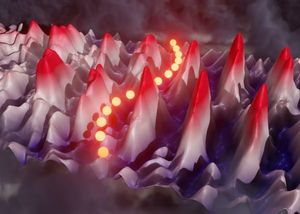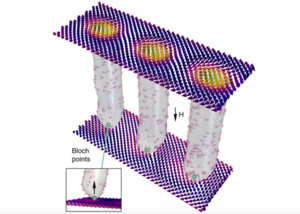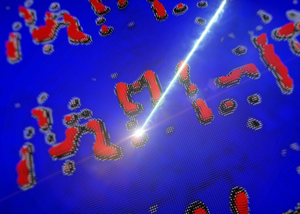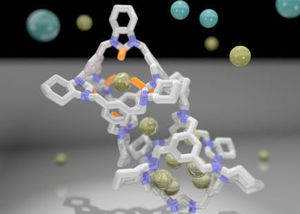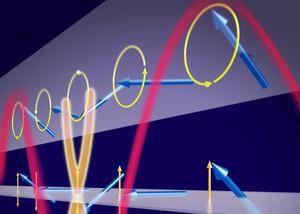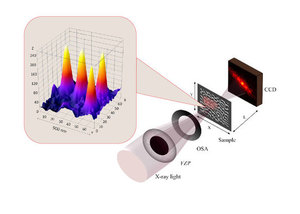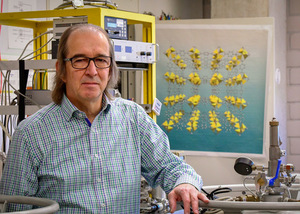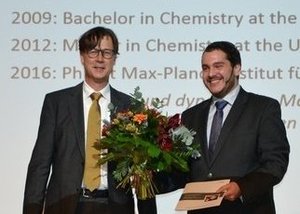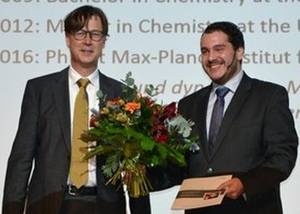Modern Magnetic Systems
News
09-09-2022
Super-dense packing of hydrogen molecules on a surface
In a paper in Nature Chemistry, scientists from the Max Planck Institute for Intelligent Systems, the Technische Universität Dresden, the Friedrich-Alexander-Universität Erlangen-Nürnberg, and Oak Ridge National Laboratory describe the formation of a superdense monolayer of hydrogen on highly ordered mesoporous silica near the boiling temperature. Theoretical studies and simulations confirm the experimental observations of the unusually high hydrogen density in the adsorbed layer and may also open new possibilities for enhancing the volumetric capacity of cryogenic hydrogen storage systems.
Rafael Balderas Xicohténcatl
Michael Hirscher
Modern Magnetic Systems
News
13-04-2022
Flexible Quantum sieve filters the fuel of Starship Enterprise
Deuterium, the heavy brother of hydrogen, is considered a promising material of the future – because of its wide range of applications: in science, for energy generation, or in the production of pharmaceuticals. However, the extraction of deuterium from its natural isotope mixture has so far been complex and expensive. With a porous material developed at the Technische Universität Dresden, this could soon be done more efficiently and cost-effectively. The new method has now been published in the scientific journal "Science Advances".
Michael Hirscher
Modern Magnetic Systems
News
09-02-2021
World's first video recording of a space-time crystal
Periodic pattern consisting of magnons is formed at room temperature
A team of researchers has succeeded in creating a micrometer-sized space-time crystal consisting of magnons at room temperature. With the help of an ultra-precise X-ray microscope, they were able to capture the recurring periodic magnetization structure in a movie. The research project “Real space observation of magnon interaction with driven space-time crystals” was published in Physical Review Letters.
Nick-André Träger
Joachim Gräfe
Gisela Schütz
Modern Magnetic Systems
News
27-08-2020
Demonstration of k-vector selective microscopy for nanoscale mapping of higher order spin wave modes
Nanoscale Backcover
Higher order spin wave modes are deconvoluted by their k-vector and directly imaged with X-ray microscopy, achieving <20 nm spatial and <40 ps temporal resolution. These real space measurements allow a direct insight into the inner workings of complex spin wave systems and reveal their fine structure and localization profi le. While confirming analytical theory on the nanoscale, design paths towards multimode signal transmission in magnonic waveguides are shown.
Joachim Gräfe
Nick-André Träger
Modern Magnetic Systems
News
30-04-2020
Scientists prove the existence of Skyrmion tubes
For the first time, an international team of researchers succeeded in demonstrating the previously unknown structure of magnetic skyrmion tubes in 3D. This knowledge makes it possible to better understand the formation and destruction of skyrmions and to use the magnetic structures in so-called spintronic storage devices.
Joachim Gräfe
Gisela Schütz
Modern Magnetic Systems
News
21-04-2020
Serendipity in the research field of magnetism
Scientists discover new light-matter interaction with which they can write nanometer-sized magnetic structures
A German-Chinese research team has discovered a new effect that for the first time enables the creation of extremely small magnetic structures, known as skyrmions, directly with an X-ray beam. The scientists have thus made it possible to write arbitrary magnetic patterns with the highest precision.
Joachim Gräfe
Gisela Schütz
Modern Magnetic Systems
News
03-11-2019
Cage molecules act as molecular sieves for hydrogen isotope separation
A new hybrid material developed by scientists at the University of Liverpool and the Max Planck Institute for Intelligent Systems may bring the dream of carbon-free nuclear fusion power a step closer.
Michael Hirscher
Modern Magnetic Systems
News
29-03-2019
Let’s not make big waves
A team of researchers generates ultra-short spin waves in an astoundingly simple material
Due to its potential to make computers faster and smartphones more efficient, spintronics is considered a promising concept for the future of electronics. In a collaboration including the Max Planck Institute for Intelligent Systems and the Helmholtz-Zentrum Dresden-Rossendorf, a team of researchers has now successfully generated so-called spin waves much more easily and efficiently than was previously deemed possible. The researchers are presenting their results in the journal Physical Review Letters.
Gisela Schütz
Joachim Gräfe
Modern Magnetic Systems
News
01-03-2019
3D structure of skyrmions becomes visible for the first time
An international team of scientists was able to make the indestructible magnetic structures visible for the first time with the aid of a high-resolution X-ray microscope.
Gisela Schütz
Joachim Gräfe
Modern Magnetic Systems
News
08-02-2019
Dr. Michael Hirscher Chair of the GRC Hydrogen-Metal Systems Conference
The head of the "Hydrogen Storage" research group at the Max Planck Institute for Intelligent Systems in Stuttgart, together with Ned T. Stetson, will lead one of the most important conferences in the field of hydrogen-material interaction. The core topic of the conference will be new hydrogen storage materials, understanding from atomic level to applications.
Michael Hirscher
Modern Magnetic Systems
News
07-09-2018
Novel polymer lenses for X-ray microscopes: highly efficient and low cost
Scientists at the Max Planck Institute for Intelligent Systems in Stuttgart invented a new and cost-effective method for making X-ray lenses with nanometer-sized features and excellent focusing capabilities. By using an advanced 3D printing technique, a single lens can be manufactured under a minute from polymeric materials with extremely favorable X-ray optical properties, hence the costs of prototyping and manufacturing are strongly reduced. High-throughput and high-yield manufacturing processes of such lenses are sought after world-wide, which is why the scientists have filed a patent for their invention.
Umut Sanli
Kahraman Keskinbora
Hakan Ceylan
Gisela Schütz
Metin Sitti
Modern Magnetic Systems
News
29-06-2018
DynaMAX Projekt erhält großzügige Mittel vom BMBF
Das Bundesministerium für Bildung und Forschung unterstützt Projekt des Max-Planck-Instituts für Intelligente Systeme innerhalb des Deutsch-Schwedischen Großforschungsprojekts Röntgen-Ångström-Cluster mit 1,2 Millionen Euro. Ein Drittel davon gehen für das Teil-Projekt DynaMAX nach Stuttgart.
Joachim Gräfe
Gisela Schütz
Modern Magnetic Systems
News
22-06-2018
Neue Phänomene im magnetischen Nanokosmos
Beobachtung magnetischer Tröpfchen große Bedeutung für die magnetische Datenprozessierung
Forscher am Max-Planck-Institut für Intelligente Systeme in Stuttgart konnten mit Hilfe eines Röntgenmikroskops bei der Bildung von magnetische Tröpfchen ein völlig unerwartetes Verhalten beobachten. Wenn der Strom über einen Nanokontakts durch die magnetische Schicht fließt, breitet er sich wesentlich weiter aus, als die Ausdehnung des Nanokontakt es zulassen sollte. Bisher waren Forscher davon ausgegangen, dass nur die Fläche unterhalb des Nanokontakts reagiert. Doch Experimente haben die Wissenschaftler eines Besseren belehrt. Ein spannendes Phänomen in der Grundlagenforschung und von großer Bedeutung für die magnetische Datenprozessierung.
Joachim Gräfe
Gisela Schütz
Modern Magnetic Systems
News
04-06-2018
Joachim Gräfe erhält Otto-Hahn-Medaille der Max-Planck-Gesellschaft
Der Nanomagnetismus-Forscher wird für seine innovative Forschung der Magnetisierungsdynamik auf der Nanoskala, insbesondere der Magnonik, durch den Einsatz modernster Röntgenmikroskopie ausgezeichnet.
Joachim Gräfe
Modern Magnetic Systems
News
23-03-2017
Nanomagnetism in X-ray Light
Today’s most advanced scanning X-ray microscope is operated by the Max Planck Institute for Intelligent Systems at Helmholtz Zentrum Berlin
The MAXYMUS scanning X-ray microscope has its home at Berlin’s synchrotron radiation source BESSY II at Helmholtz Zentrum Berlin. Scientific support is provided by Dr. Markus Weigand from the “Modern Magnetic Systems” department at the Max Planck Institute for Intelligent Systems (MPI-IS) under the management of Professor Dr. Gisela Schütz..
Gisela Schütz
Modern Magnetic Systems
News
20-12-2016
Ernst Eckhard Koch Prize for Joachim Graefe
On December 8, The Association of Friends of Helmholtz-Zentrum Berlin granted the Ernst Eckhard Koch Prize for an outstanding PhD thesis in the research area of synchrotron radiation as well as the innovation prize “Synchrotron Radiation”. The award ceremony took place at the 8th BER II and BESSY II Users’ Meeting.
Joachim Gräfe
Modern Magnetic Systems
News
20-12-2016
Ernst Eckhard Koch Prize for Joachim Graefe
On December 8, The Association of Friends of Helmholtz-Zentrum Berlin granted the Ernst Eckhard Koch Prize for an outstanding PhD thesis in the research area of synchrotron radiation as well as the innovation prize “Synchrotron Radiation”. The award ceremony took place at the 8th BER II and BESSY II Users’ Meeting.
Joachim Gräfe
Modern Magnetic Systems
News
05-12-2012
Deuterium from a quantum sieve
A metal-organic framework separates hydrogen isotopes more efficiently than previous methods.
In future it may be easier for chemists, biologists and physicists to obtain the ideal substance with which to clarify numerous research issues. For the first time, a team of scientists from the Max Planck Institute for Intelligent Systems in Stuttgart, Jacobs University Bremen and the University of Augsburg have been able to apply a new method to separate hydrogen and its heavier isotope deuterium more efficiently than before. To this effect, they use a metal-organic framework as a quantum sieve to separate the isotopes. Deuterium serves to determine the structure of unknown substances, for example. Chemists also use it to investigate how reactions involving hydrogen proceed and thus create the basis on which to optimise the conversion. Biologists use deuterium to analyse metabolic processes, among other things.
Michael Hirscher
Modern Magnetic Systems
News
12-04-2011
A quick switch for magnetic needles
Magnetic vortex cores, which can be used as particularly stable storage points for data bits, can now be switched much faster.
Microscopically tiny ferromagnetic platelets exhibit a phenomenon which could be exploited in the future for particularly stable magnetic data storage: so-called magnetic vortex cores. These are needle-shaped magnetic structures measuring 20 nanometres (millionths of a millimetre) in diameter. Five years ago, researchers at the Max Planck Institute for Intelligent Systems (formerly the Max Planck Institute for Metals Research) in Stuttgart found a way to reverse the magnetic field needles despite their stability using only a tiny amount of energy so that their tips pointed in the opposite direction. Such a switching process is necessary to enable the vortex cores to be used in data processing. The Stuttgart scientists have now discovered a new mechanism which makes this switching process at least 20 times faster and confines it to a far smaller region than before. Magnetic vortex cores could thus provide a means of data storage which is stable, fast and greatly miniaturized.
Hermann Stoll



